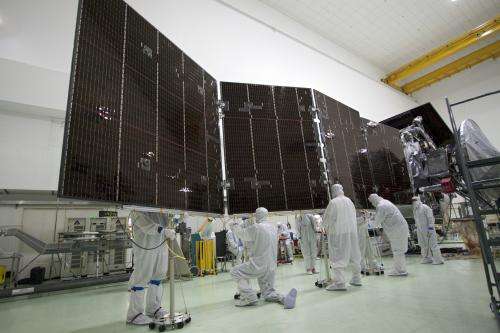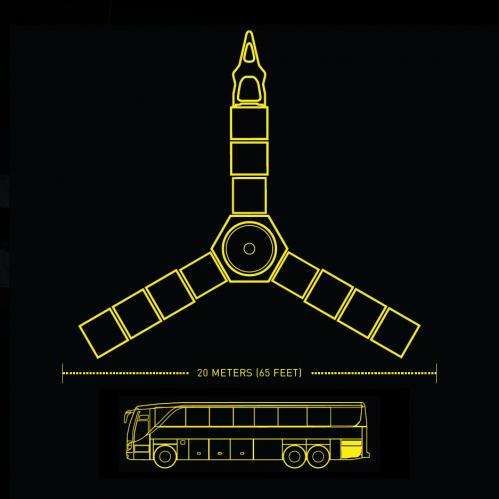Juno solar panels complete testing

The three massive solar panels that will provide power for NASA's Juno spacecraft during its mission to Jupiter have seen their last photons of light until they are deployed in space after launch. The last of the Jupiter-bound spacecraft's panels completed pre-flight testing at the Astrotech payload processing facility in Titusville, Fla., and was folded against the side of the spacecraft into its launch configuration Thursday, May 26. The solar-powered Juno spacecraft will orbit Jupiter's poles 30 times to find out more about the gas giant's origins, structure, atmosphere and magnetosphere.
"Completing the testing and stow of solar panels is always a big pre-launch milestone, and with Juno, you could say really big because our panels are really big," said Jan Chodas, Juno's project manager from NASA's Jet Propulsion Laboratory in Pasadena, Calif. "The next time these three massive solar arrays are extended to their full length, Juno will be climbing away from the Earth at about seven miles per second."
This is the first time in history a spacecraft has used solar power so far out in space (Jupiter is five times farther from the sun than Earth). To operate on the sun's light that far out requires solar panels about the size of the cargo section of a typical tractor-trailer you'd see on the interstate highway. Even with all that surface area pointed sunward, all three panels, which are 2.7 meters wide (9 feet), by 8.9 meters long (29 feet), will only generate about enough juice to power five standard light bulbs -- about 450 watts of electricity. If the arrays were optimized to operate at Earth, they would produce 12 to 14 kilowatts of power.

In other recent events, the 106-foot-long (32-meter-long), 12.5-foot-wide (3.8-meter-wide) first stage of the United Launch Alliance Atlas V launch vehicle that will carry Juno into space arrived at the Skid Strip at Cape Canaveral Air Force Station on May 24, aboard the world's second largest cargo aircraft -- a Volga-Dnepr Antonov AN-124-100. The two-stage Atlas V, along with the five solid rocket boosters that ring the first stage, will be assembled and tested on site at Launch Complex-41 at Cape Canaveral this summer.
The launch period for Juno opens Aug. 5, 2011, and extends through Aug. 26. For an Aug. 5 liftoff, the launch window opens at 8:39 a.m. PDT (11:39 am EDT) and remains open through 9:39 a.m. PDT (12:39 p.m. EDT).
More information: More information about Juno is online at www.nasa.gov/juno
Provided by JPL/NASA




















